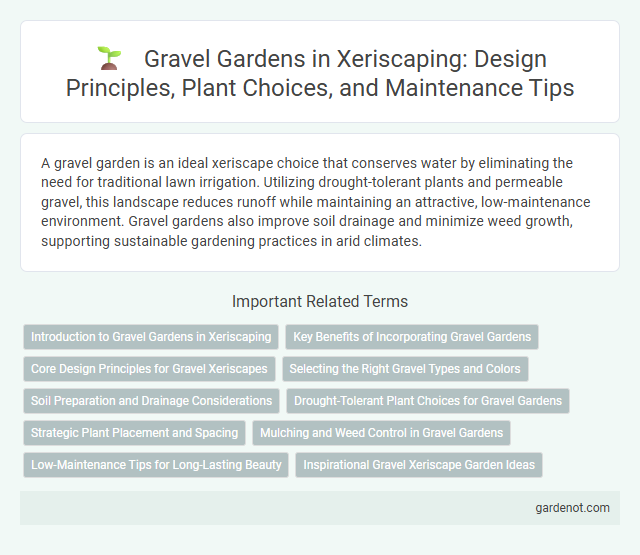A gravel garden is an ideal xeriscape choice that conserves water by eliminating the need for traditional lawn irrigation. Utilizing drought-tolerant plants and permeable gravel, this landscape reduces runoff while maintaining an attractive, low-maintenance environment. Gravel gardens also improve soil drainage and minimize weed growth, supporting sustainable gardening practices in arid climates.
Introduction to Gravel Gardens in Xeriscaping
Gravel gardens play a crucial role in xeriscaping by providing excellent drainage and reducing water consumption through the use of small, porous stones. These gardens create a minimalist, low-maintenance landscape that supports drought-tolerant plants such as succulents, cacti, and native perennials. Incorporating gravel mulch also helps to suppress weeds, retain soil moisture, and maintain soil temperature, enhancing plant health in arid environments.
Key Benefits of Incorporating Gravel Gardens
Gravel gardens significantly reduce water consumption by enhancing soil drainage and minimizing evaporation, making them an ideal choice for xeriscaping in arid climates. Their permeable surfaces prevent soil erosion and promote sustainable stormwater management, limiting runoff and recharging groundwater. Low maintenance requirements and weed suppression further contribute to long-term environmental and economic benefits in drought-prone regions.
Core Design Principles for Gravel Xeriscapes
Gravel xeriscapes emphasize water conservation through strategic soil preparation and proper gravel selection to enhance drainage and minimize evaporation. Incorporating drought-tolerant plants with deep root systems stabilizes the landscape while reducing irrigation needs. Layering gravel with mulch and using adaptive planting patterns further optimize moisture retention and soil health in arid environments.
Selecting the Right Gravel Types and Colors
Choosing the right gravel types and colors is essential for an effective xeriscape gravel garden, as it enhances both functionality and aesthetic appeal. Opt for angular gravel for better drainage and stability, while rounded gravel offers a softer look but may shift more easily. Incorporate natural earth tones such as tans, browns, and grays to blend seamlessly with drought-tolerant plants and reduce heat absorption in sunny areas.
Soil Preparation and Drainage Considerations
Gravel garden soil preparation requires well-draining, sandy or loamy soil to prevent waterlogging and promote healthy root growth. Incorporating organic matter and coarse sand improves soil texture and enhances drainage, essential for xeriscape plant success. Proper grading and installation of a drainage system ensure excess water flows away, reducing erosion and root rot risks in gravel gardens.
Drought-Tolerant Plant Choices for Gravel Gardens
Gravel gardens thrive with drought-tolerant plants such as lavender, sedum, and ornamental grasses, which require minimal water and adapt well to well-drained, rocky soil. Succulents like echeveria and stonecrop add texture and color while conserving moisture in arid conditions ideal for xeriscaping. Incorporating native drought-resistant species benefits gravel garden sustainability by enhancing soil retention and reducing irrigation needs.
Strategic Plant Placement and Spacing
Strategic plant placement and spacing in a gravel garden optimize water efficiency and plant health by minimizing competition for resources. Proper spacing ensures adequate airflow and reduces the risk of disease, while grouping plants with similar water and sunlight needs promotes sustainable growth. Incorporating drought-tolerant species spaced to allow root expansion enhances soil absorption and drainage in xeriscape designs.
Mulching and Weed Control in Gravel Gardens
Mulching in gravel gardens conserves soil moisture and reduces evaporation, promoting drought-resistant plant growth typical of xeriscaping. A layer of organic or inorganic mulch minimizes weed germination by blocking sunlight and creating a hostile environment for weed seeds. Effective weed control in gravel gardens often combines mulching with landscape fabric beneath the gravel to further suppress weed intrusion while maintaining soil aeration.
Low-Maintenance Tips for Long-Lasting Beauty
Gravel gardens require minimal upkeep by selecting drought-tolerant plants and using high-quality, weed-resistant gravel to suppress unwanted growth. Regularly removing debris and replenishing gravel annually ensures optimal drainage and maintains aesthetic appeal. Incorporating drip irrigation systems delivers precise moisture, further reducing maintenance efforts while promoting plant health.
Inspirational Gravel Xeriscape Garden Ideas
Gravel xeriscape gardens maximize water conservation while providing a low-maintenance, aesthetically pleasing landscape option. Incorporating drought-resistant plants such as succulents, ornamental grasses, and native shrubs enhances texture and color contrast against the gravel, creating a harmonious, sustainable design. Strategic placement of boulders and pathway edging defines garden zones, promoting both functionality and visual appeal in gravel-based xeriscaping.
Gravel garden Infographic

 gardenot.com
gardenot.com